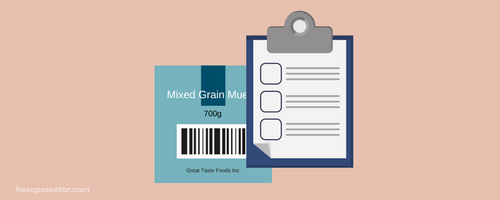Food labelling is our way to communicate key information to our customers. However, getting this wrong can result in our business being exposed to litigation, recall and even illness of our consumers. In the Ultimate Guide to Food Labelling find out what you need to know when labelling your food products, how to check that information is correct and get links to relevant regulatory requirements and resources.
Table of contents
- What is food labelling?
- Why is food labeling important?
- Food labelling requirements
- Designing your food labels
- Reviewing and approving artwork
- Ingredient and allergen information
- Nutritional Data
- Health and Product Claims
- Country of Origin
- Finished product weights and measures
- Communicating food safety risk to your customers
- Determining a food products shelf-life
- Implementing food product traceability
- How to check that your food label is accurate
- Food labelling regulatory links
What is food labelling?
The FAO describes food labeling as “any written, printed or graphic matter that is present on the label, accompanies the food, or is displayed near the food, including that for the purpose of promoting its sale or disposal.” It serves to communicate information about the food to the consumer or user.
Why is food labeling important?
Food labelling plays an important role in educating consumers and users about what is in the food product, how to handle and store it, where is has come from and when it will become unsafe or unsuitable to consume.
Food labelling requirements
As a food manufacturer you are legally required to label any food product that you produce. The level or extent of mandatory information will depend on your location and governing food laws. It will also relate to if your product is packaged and if you are selling directly to the consumer. Failing to adhere to relevant regulations can result in serious consequences for both the consumer and your food business.
At a minimum and depending on your location and country of export, your food labelling should include:
- Name / description of the food
- Ingredient listing
- Allergens
- Nutritional information
- Best-before or use-by dates
- Storage directions
- Preparation and handling instructions
- Lot identification for traceability
- Country of origin
- Contact details including name and address of the producer/agent
- Applicable weights or measures
These requirements are all dependent on food labelling laws in your country of manufacture and in any country that you may be exporting.
Designing your food labels
In addition to the mandatory information that is required to be included on or with your product you also need to consider your design. Design must incorporate legibility, adequate font sizes and contrasting print and backing colours. The goal is for consumers and end users to be able to effectively read any information provided. The readability of the product barcode is essential to ensure smooth transactions when using scanners.
Your local regulations may also stipulate where certain information must appear on the food labelling. This could be on the front, back, top, bottom or side of the food packaging.
Reviewing and approving artwork
It is essential that you never order printed food labels or food packaging without first checking each section of the artwork. This includes making sure that ingredient lists, marketing claims, allergen declarations, nutritional panels, country of origin and warning statements are true and correct.
I have spoken before about those crazy marketing people who like to run with a product label without first consulting relevant experts. The function of ‘review and approve’ needs to include representatives from the QA and the regulatory affairs department. Unfortunately, I have seen many situations where the marketing team has had sole responsibility for label design, review, and approval. It always ends in tears when the design is incorrect and does not comply with the food labelling laws.
Advisory
If you do not have expertise in-house contact a reputable food safety consultant or food labelling expert to help you.
Ingredient and allergen information
Fundamental to the food labelling process is declaring what ingredients are in your products. Based on your governing food laws you may also need to label characterising ingredients, food additives, and if the ingredients have been derived from genetically modified materials.
Declaring allergens is important as some food ingredients, and food components can induce severe allergic reactions, including anaphylaxis. Many food labels use ‘may contain’ or ‘may be present’ statements about certain allergens, such as ‘may contain nuts’. These statements may or may not be regulated in your relevant food labelling laws.
HACCP Mentor provides guidance in managing food allergens and avoiding cross-contact in our Allergen Awareness and VITAL® Online for Allergen Management training.
Nutritional Data
Many consumers use the nutritional data that you include on your food labelling to manage health issues. This can include health states like high cholesterol, obesity and high blood pressure. Anyone needing to lose weight may use the overall energy (calories or kilojoules) to help understand what they are putting into their bodies.
This may also be the same for protein consumption by athletes. To help ensure that this information is correct on your food labelling, completing either laboratory-based analysis or data calculation using the raw materials and recipe will be required. You may find our post on “How to calculate product nutritional information” helpful especially if you are new to food labeling.
Health and Product Claims
It seems that I cannot pick up any type of food product these days with seeing a myriad of health and other claims made about the product. Common claims include gluten free, organic, paleo, high protein, farm fresh, low fat, no sugar and halal, to name a few.
If your food labeling contains any type of claim, make sure you can verify the claim. You will need to have credible evidence to support their use along with complying with any applicable food legislation. You can learn more about health and product claims by clicking here.
Country of Origin
Keeping with the roll of product claims you may also be legally required to indicate the “Country of Origin” as part of your food labelling. If you choose to make a country of origin claim, or are legally required to do so, it must be clear, accurate and truthful.
Finished product weights and measures
Although not a food safety issue, finished product weights can be considered a fraud or misleading consumer issue. The majority of countries will have some type of weights and measures requirements. If your food labelling states that the product weighs say 500g, you need to make sure that this is the case.
Regular weight checks during the manufacturing process should be completed on the finished product. This will help to verify that your product is not underweight.
Communicating food safety risk to your customers
Globally, the primary mechanism for food safety risk communication is via food labelling. In the majority of countries, this is mandated through the regulatory framework, which requires information like ingredients, expiry dates, allergen status, storage and cooking instructions to be included on packaged foods.
But does this go far enough in educating your customer or consumer about your product? Do your customers read your product labelling or better still, do they understand what it means? According to UNESCO at least 758 million youth and adults, globally, cannot read and write. Back in 2018, I presented innovative ways, in addition to labelling, to further educate your customer and/or consumer on how to ensure the safety of your food product. You can watch the recorded presentation here.
Determining a food products shelf-life
As part of your regulatory compliance all relevant products will need to contain some type of shelf-life statement. This is normally in the form of a best-before or use-by date. As I mentioned previously, expiry dates are key when communicating a products food safety risk. It is essential that you do not merely take a random guess or use your competitors date coding on your products. You must also consider the products intended storage conditions. I have written an in-depth post on “How to set your food expiry date” which will provide you further guidance if needed.
Implementing food product traceability
A mandatory requirement for a food business is to be able to trace your finished product forward to the customer and backward through your production system to raw material supply. Having an effective traceability system will also help your business to comply with food recall requirements and customer standards.
From a finished product perspective, you may choose to use the expiry date we mentioned above as your trace code. Alternatively, additional identification such as lot or batch code can be added to your food label or product packaging. Whichever format you choose, make sure that it is legible and indelible.
FSMA Rule on Food Traceability
If you are located within the USA, the FDA has now published additional traceability recordkeeping requirements. The aim of these requirements is to help the FDA rapidly and effectively identify recipients of those foods to prevent or mitigate foodborne illness outbreaks and address credible threats of serious adverse health consequences or death.
How to check that your food label is accurate
Throughout this post I have mentioned the need to ensure your food labelling is legible, accurate and truthful. The best way to do this is through the verification process. By following the steps listed in our ‘How to verify your food labels’ article you can easily reduce the risk of incorrect food packaging reaching your customer and any potential legal action.
Food labelling regulatory links
Before I wrap up this Ultimate Guide to Food Labelling, I want to share some regulatory links to food labelling requirements. Labelling laws can be confusing at the best of times and spread out across many different reference points. I highly recommend getting specialist advice especially if you export your food products to another country.


